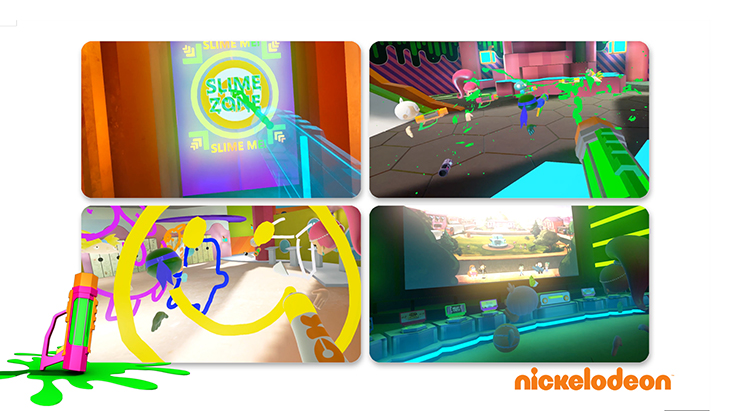Nickelodeon’s SlimeZone is more than just a game.
The social VR experience, which debuted over the summer at Vidcon, immersed hundreds of kids into an interactive world where they could teleport to different rooms and shoot green goo at each other, blast cartoon targets at a shooting gallery, fire oversized basketballs into a hoop, and use virtual markers to paint in the air.
Using Oculus Rift headsets, the animated open world is one of the projects to come out of Nickelodeon’s Entertainment Lab—a research facility spearheading long-range interactive technologies across virtual reality, virtual cinema, augmented and mixed reality, real-time rendering, artificial intelligence and virtual production, while defining new ways to communicate and connect with digital audiences.

“Our Entertainment Lab is a way to give our artists and creators access to innovative tools to inspire new ways to tell stories for the next generation of kids,” Cyma Zarghami, president, Nickelodeon Group, said in May. “We are working with technology partners, gaming and visual effects companies and our own creators to bring our IP to new platforms, in new formats, and faster.”
It’s led by Chris Young, senior vice president, Nickelodeon Entertainment Lab.
“We’ve got the support and leadership around wanting to invest in innovation,” Young said.
One of the common threads across projects at the Entertainment Lab is developing ways to go beyond linear storytelling by rendering existing characters and assets into real-time AR and VR experiences.
“A big piece is looking at virtual cinema,” Young said.
For instance, Nickelodeon’s original TV movie Escape from Mr. Lemoncello’s Library uses 2D puppets and 3D puppet animation with full body and facial performance capture to create scenes that show VR technology in real time.
“It basically simulates what a kid would be seeing in VR in a live-action movie,” he said.
It’s projects like this that are paving the way for developments such as creating characters with the ability to interact with users in real time on social platforms, which also requires incorporating technology like artificial intelligence and natural language processing.
“I would say we’re in the very early days of these technologies,” he said. “We’re just now starting to scratch the surface of what the possibilities are.”
AR and VR are a current focus for the lab, especially since society is at a point where that technology is becoming commercially available. It’s no secret that it’s on many media companies’ radars, but “Nickelodeon has a very unique position because we’re a leader in the kids space,” Young said. “This is an area that feels like a natural fit for us.”
In fact, instinct is often a main driver when it comes to the projects the Entertainment Lab looks at developing. Strategy is often based on first impressions, on having a handle on what’s working and what’s not, on recognizing the projects that strike the right tone for the brand, and that get people excited.
Typically, the Entertainment Lab is looking far down the road at new opportunities.
“That’s the hardest thing, there’s so many cool new technologies coming online,” Young said. “So much hardware and software … plenty of things to get our hands dirty with.”
Those at the lab have the freedom to tinker and dabble in projects that nobody may ever see; that may fail miserably; shed light on a new idea; create opportunities that position the company to be ready to run with whatever cutting-edge technology eventually emerges with the potential to impact the future.
Being on the forefront of finding new ways to communicate and entertain is “core to continuing to be the leader in the kids space,” Young said.
The youthful audience “inherently understands the language required,” and the demographic provides a wealth of information when it comes to research and feedback at every opportunity Nickelodeon can get.
At Vidcon, more than 12,000 kids participated in the SlimeZone demo over the course of three days. Over 94 percent wanted to go through the experience again, and over 75 percent said they would recommend it to their friends, Young said.
One of the key features was the ability for kids to virtually interact with each other. Their parents could even get involved via an arcade-style machine turned in-game spectator camera where outsiders could fire objects at players in the game.
“Kids really want to have shared experiences,” Young said. “We’re putting entire families together.”
The Entertainment Lab is currently developing more location-based opportunities for SlimeZone, and figuring out the best way to make it publically available down the line.
“I think it’s the early days of how you can step inside a Nick metaverse,” he said.
Developing new ways for audiences to experience and interact with the company’s IP is a powerful driver for Young.
“Just turning on light bulbs for people is really part of the fun,” he said. “Just giving somebody the tools they didn’t know existed to help enable them to tell their stories and bring their ideas to life.”
Tags:













































__twocolumncontent.jpg)











